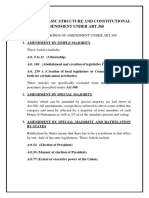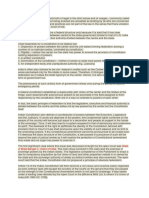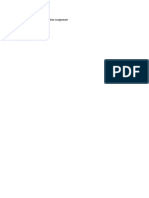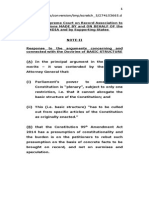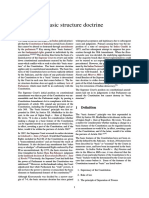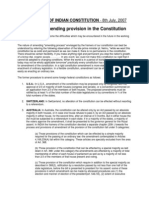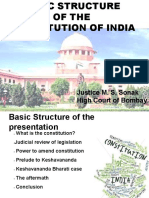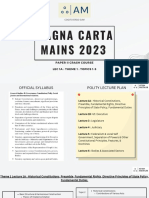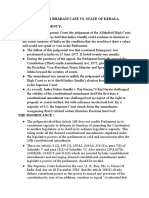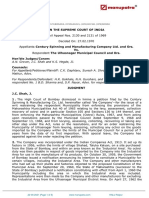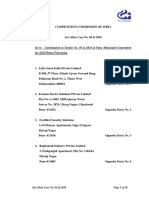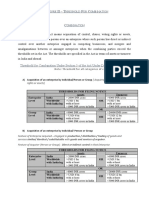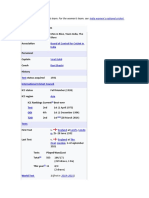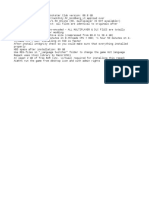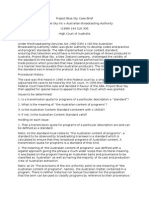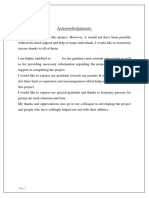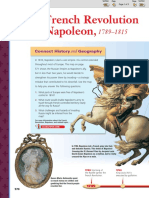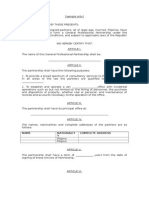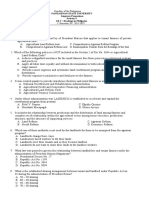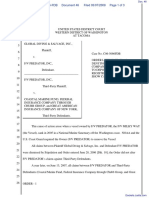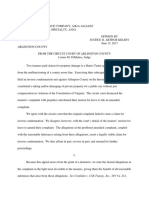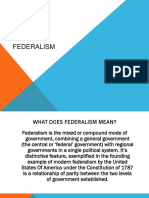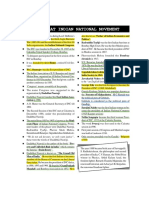PLEADINGS
1. Article 172(2) under the 104th Amendment Act, 2019 is violative of the
Basic Structure of the Constitution.
Indian Constitution is basically federal in form and is marked by the traditional characteristics of a
federal system. In Ganga Ram Moolchandani v. State of Rajasthan1, the Supreme Court restated:
Indian Constitution is basically federal in form and is marked by the traditional characteristics of a
federal system, namely supremacy of the Constitution, division of power between the Union and
States and the existence of an independent judiciary.
In the Kesavananda Bharati vs. State of Kerala2 case, the Supreme Court ruled that all provisions of
the constitution, including Fundamental Rights can be amended. However, the Parliament cannot
alter the basic structure of the constitution like secularism, democracy, federalism, separation of
powers. It held that the Basic Structure is not a vague concept at all.
The “Basic Structure” doctrine is the judge-made doctrine whereby certain features of the
Constitution of India are beyond the limit of the powers of amendment of the Parliament of India. No
part of the Constitution may be so amended by Article 368 so as to “alter the basic structure” of the
Constitution. This was also held in Minerva Mills v Union of India3.
In the case of Kuldip Nair v Union of India4, it was held that federalism is a part of the Basic structure
doctrine. The Supreme Court has upheld the same in the case of S.R Bommai v Union of India.
In 1975, in the case of Indira Gandhi v Raj Narain5, the Supreme Court again had the opportunity to
pronounce on the basic structure of theConstitution. A challenge to Prime Minister Indira Gandhi's
1
AIR 2001 SC 2616
2
AIR 1976 SC 1461
3
AIR 1980 SC 1789
4
AIR 2006 SC 3127
5
AIR 1975 SC 2299
�election victory was upheld by the Allahabad High Court on grounds of electoral malpractice in 1975.
Again, each judge expressed views about what amounts to the basic structure of the Constitution.
According to Justice H.R. Khanna, Democracy is a basic feature of the Constitution and includes free
and fair elections. In 1978 Maneka Gandhi v. Union of India case, the Supreme Court extended the
doctrine's importance as superior to any parliamentary legislation. According to the verdict, no act of
parliament can be considered a law if it violated the basic structure of the constitution.
In M Nagraj & Ors. v. Union of India & Ors.6 ,the Constitution Bench of the Supreme Court dealing
with the issue of basic structure observed that “axioms like secularism, democracy, reasonableness,
social justice, etc. are overarching principles which provide linking factor for principles of
fundamental rights like Articles 14, 19 and 21. These principles are beyond the amending power of
Parliament. They pervade all enacted laws and they stand at the pinnacle of the hierarchy of
constitutional values”. Such rights have to be respected and cannot be taken away.
Thus it is clearly proven that the Basic Structure of the Constitution cannot be altered and that
Federalism and the Right to Free and Fair elections come under the Basic Structure Doctrine as well.
Conducting simultaneous elections will be violative of the Basic Structure of the constitution on the
aforementioned grounds.
In addition to this, conducting Simultaneous elections will require at least five constitutional
amendments and has several other disadvantages as well. Articles 83 (dealing with the duration of
Houses of Parliament), 85 (dealing with the dissolution of Lok Sabha by the President), 172
(dealing with the duration of state legislatures), 174 (dealing with the dissolution of state assemblies)
and 356 (dealing with the imposition of President’s Rule on a state). These qualify under the ‘rights’
and ‘impact’ test and thus are important.
6
AIR 2007 SC 7
�It directly affects the principle of federalism and has a grave risk of the Centralisation of powers. The
Nation wide parties have a wider reach pan the nation and the regional parties especially the ones
without any National alliance would be affected as a result of this. Interests of the minority regions
would be ignored and there is a very good chance of the State govt becoming almost a subordinate to
the Centre. Other issues include the mindset of the voter, logistical issues, lack of awareness, and
many others.
Also, the whole amendment is arbitrary and can also be brought under Art.14 of the Constitution for
arbitrariness. The basis for the amendment was also on an Online Referendum which cannot be a
basis for conclusions due to low literacy rates of people as well as lack of awareness on the advantages
and disadvantages of the same. While the move may have some advantages the cons outweigh. Thus
it is humbly submitted that Art. 172(2) is violative of the basic structure.


